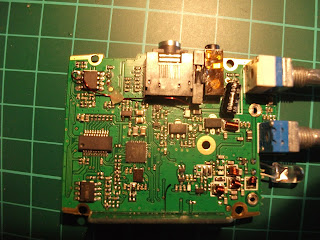The output connector on the Nokia UMTS power amplifier comes in two different types.
For boards with final transistor type BLD6G22L-150BN/2 it has an AFI socket that normally
uses a bullet adapter to allow board to board connectivity, this is an Amphenol system and
normal SMA to AFI adapters are very expensive, so some hams have removed or bypassed the
connector entirely, here I have decided to use the existing socket and use a home made adapter.
On the first photo I have used a AFI pcb plug and a SMA pcb connector soldered together to
make an appropriate adapter for service in the final amplifier for use at 2.4Ghz on the QO100
satellite. The AFI plug is available from Farnell part number 26644609.
For boards with final transistors type BLF8G22LS-160BV it has a SMP-MAX socket.
Note of caution, normal SMP to SMA adapters wont fit so you will need the SMPMAX to SMA
of the type available from Mouser part number 538-73386-1560.
Fabricated adapter is completed by wrapping a strip of adhesive backed copper foil, to improve
RF shielding.











